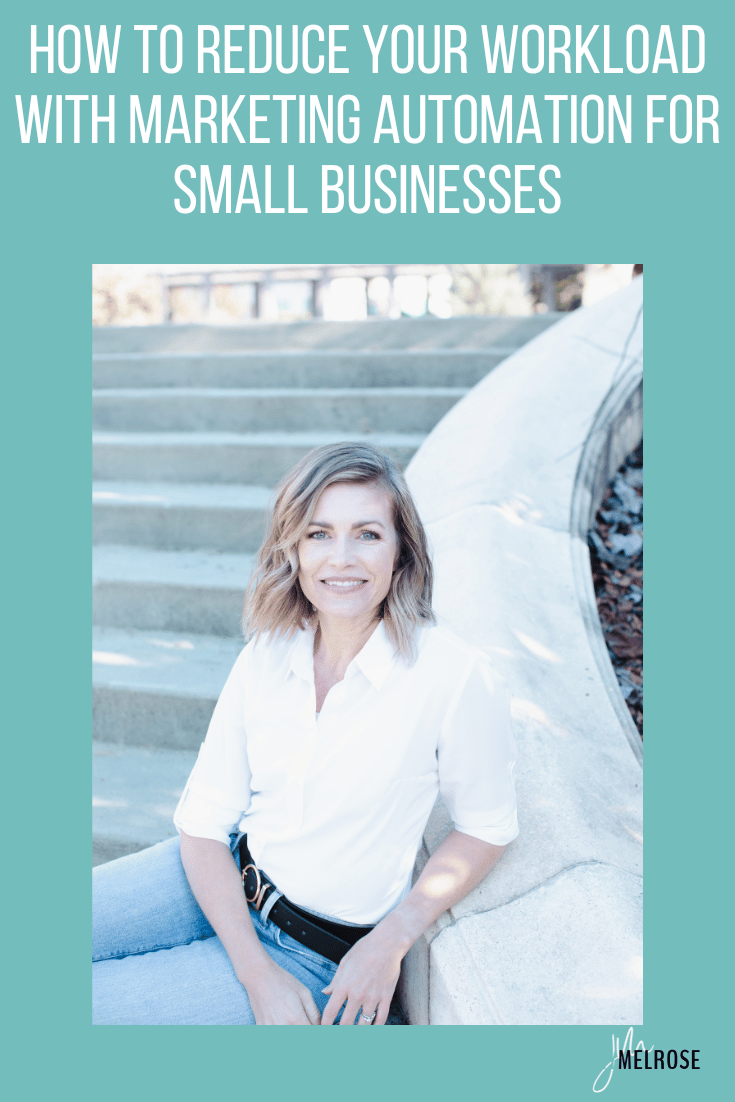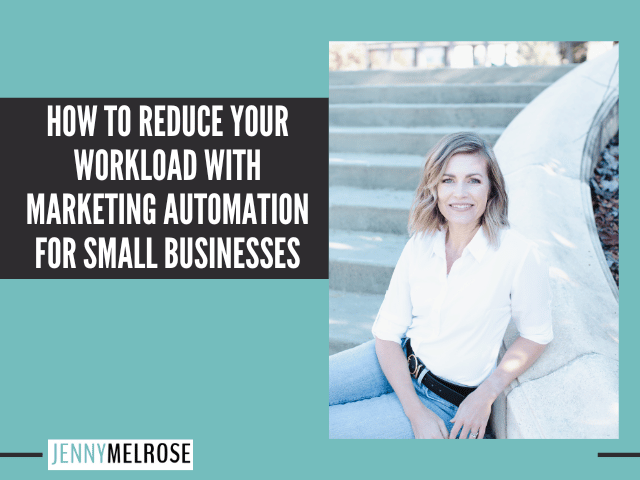Learn how to effectively reduce your workload using marketing automation tools and techniques.
IE 393: How to Reduce Your Workload with Marketing Automation for Small Businesses

Lindsey is from Charlotte, NC. She is a wife and a mom of two little girls. She has a traditional marketing agency, Lindsey Wagnon Marketing. She also has Savvy Startup Marketer which is more of a DIY resourcing option to help newer business owners get good lift at the beginning of their marketing journey.
What is marketing automation?
Marketing automation includes all of the ways you continue to reach out to your audience so that it automatically happens and reduces your workload. It uses technology to set up automation that will run automatically with little management or maintenance.
Yet, it will continue to run and take care of usual marketing tasks. For example, communicating with people, bringing in leads, and keeping the flow of messaging going through the customer journey.
Lindsey encourages new business owners not just to set up platforms and technology but to reduce their workload and daily tasks so that they will not need to use extra energy or have continued decision-making.
You are automating yourself, making solid plans, which you put on the calendar, and then not thinking about it so you get into good systems and rhythms in business and marketing. You are leaning on platforms and tech to establish good routines and be consistent.
Jenny loves routines and sits down every Sunday to define what her week will look like. What needs to be done? Does she have a meeting, podcast interview, or need to sit down and create the podcast? Marketing automation
What are the key functions of marketing automation?
Communication with leads and getting them to your email list is a big part of marketing automation. You want to continually talk to people and nurture your relationship. You also want to keep up with your customers.
Conversion. Along with that, if your communication is dialed in and you know that message is working for conversion, that will lead to more customers and followers and greater sales.
Customer experience is another big part of marketing automation. After someone buys your product or service, you want to make sure they are getting communication from you regularly and they feel like you are walking with them at every step and they are not left out of the loop.
You want them to know what actions they need to take and not go silent. They may be looking for the next product, service, or thing you offer.
Customer follow-up is another component of marketing automation. After you have established a relationship and made a sale, following up and keeping the conversation going is important.
You may get repeat business from it and even if you do not, it could still be a really great testimonial or source of referrals for you.
This is the easiest way to grow your email list because it helps you with the follow-up or conversions to people who have just found you. They see the benefits and solutions you have through your conversations with them.
You want to continually get in front of your audience. Email is the one reliable platform that you know reaches your audience.
If you are sending the people on your list regular emails, they are most likely going to see your messaging. They know you will take care of them, continue to help, and provide for them.
More resources and tools are becoming available to get your message to people but you should start with email automation and use them to the fullest potential. You will be utilizing your list without having to do it manually.
It helps you get into the routine of consistently emailing your audience and consistently writing them at least once a week to share your latest blog post or the product that might be most relevant to them.
What are the benefits of marketing automation?
The biggest benefit of marketing automation is time-saving and taking tedious tasks off our list that we do not need to be doing manually. It also saves your mental energy and the need to make decisions.
When you set up your automation, you have pre-decided what you are going to communicate. You have spent the mental energy to create something that automatically goes out to your audience. It saves brain space so that as a business owner, you can move forward with other things.
It may not feel like it is saving you anything in the beginning. Don’t let the set-up of marketing automation become overwhelming, cause you to do it in pieces, or procrastinate and not do it.
In the beginning, the more you can do to set up the automation, using the platform to its fullest potential, the more time you will save later. Setting it up well should feel like you have cloned yourself and created your own assistant to save time.
You will also have increased engagement because you are communicating more. This will lead to more responses, people being more aware of your offers, and increased sales.
You can use this to have your customers become your best marketers to save you time, and energy, and help you gain traction. If they are happy with your services/products and also the communication they received during the transaction, it encourages referrals.
Taking care of your customers so well that they become your best marketing source is the ultimate goal of marketing.
When you have marketing automation in place, it can provide you with great data. It can show you what is working and what is not.
What topics are they more interested in because they are clicking or opening more? What subject lines are they really interested in?
Being consistently in front of them helps you become more aware and see what they need the most. You can do more experimenting with what you send out and set up in platforms.
You want to have good analytics set up to inform yourself how things are going. You can tweak the things you are doing based on the results you see to continually improve your marketing and sales.
How do you choose the right marketing automation for your small business?
At the beginning, particularly for the bootstrapping business owner who is trying to not spend a lot of money, you can start with a free (or almost free) way to connect a few platforms to get set up and automated.
You need a good website with a pop-up lead magnet. Connect that to the email platform. Spend some time getting automated email workflows ready to go. This is good to do before your first leads come in.
Have customer follow-up ready, before you even have a customer. Focus on your customers from the moment they get converted and buy. That follow-up includes feedback forms to give you vital feedback and helpful information.
Add links for reviewing your business. Later you can add enhancements such as text messaging or automated Facebook Messenger responses. That way, as soon as someone connects with your business, you are communicating with them.
You can set up automated answers for FAQ’s. Chatbots are great when you have an online store or go to your website. It helps people feel like they have more support if they need you or an extra level of customer service.
A social proof platform is another automation to add on early in your marketing journey, particularly if you are selling products. It adds a little bit of credibility and FOMO for those who are wondering if they should buy your products.
Many tools are free or low-cost to automate and help you run your business.
One way to determine what you need for marketing automation is to consider the things you would hire an assistant for right now. What tasks or business responsibilities would you hand over to them? The things on that list are what you want to automate.
Picture your business 3-5 years from now. Go through every step of your interaction with customers, from attracting them as a lead through to them becoming a customer with a great experience, and to following up with them to review the interactions.
Figure out what steps of this can be automated to help save yourself time as your customer moves from stranger to customer.
What are some of the top marketing automation tools that you use?
- Email – Covert Kit.
- Google Business Profile – You can get more local searches even if your business is more global. Google likes you using their stuff and it gives you a better chance of being seen by others.
- Google Forms – This is free and you can add it to your workflow emails to do market research. You can also use it to follow up with your customers on how their experience was, how you can improve, and get testimonials. Google has an email form notification option that will alert you when someone has filled out the form.
- Zapier helps you connect your platforms or allows you to add more technical options for you.
- HubSpot has a Chatbot that is free as part of their platform.
One Google Hack for you is to consistently check the Google menu to see what business apps they have added for you to use.
They constantly come out with free apps that you can use that apply to different areas of business, such as scheduling options and meeting platforms that will help you automate.
Marketing Essentials Toolkit
Lindsey is offering a Marketing Essentials Toolkit. This operates as a marketing planner, coach, business planner, and a fillable planner all in one. It guides you through setting business goals, establishing a budget, and the time you want to spend on your business.
It includes The Marketing Mindset to help you think like a professional marketer and walk you through decisions you would make for your business and choose marketing strategies based on those decisions. You map out your customer journey, and determine SEO, and other checklists to help you get organized with your marketing.
ACTION ITEMS
- If you liked this episode of Influencer Entrepreneurs, please subscribe and leave a fabulous review!
- Ready to go deeper into your business? Join the Insiders Group at the special rate for podcast listeners.


